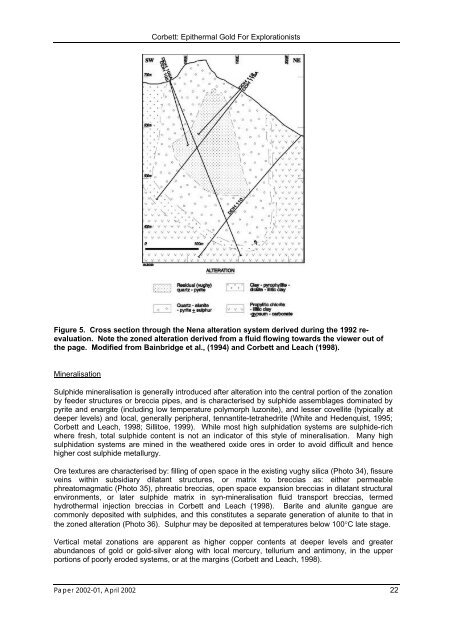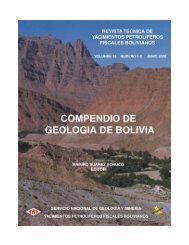Exploraciones por oro epitermal
You also want an ePaper? Increase the reach of your titles
YUMPU automatically turns print PDFs into web optimized ePapers that Google loves.
Corbett: Epithermal Gold For Explorationists<br />
Figure 5. Cross section through the Nena alteration system derived during the 1992 reevaluation.<br />
Note the zoned alteration derived from a fluid flowing towards the viewer out of<br />
the page. Modified from Bainbridge et al., (1994) and Corbett and Leach (1998).<br />
Mineralisation<br />
Sulphide mineralisation is generally introduced after alteration into the central <strong>por</strong>tion of the zonation<br />
by feeder structures or breccia pipes, and is characterised by sulphide assemblages dominated by<br />
pyrite and enargite (including low temperature polymorph luzonite), and lesser covellite (typically at<br />
deeper levels) and local, generally peripheral, tennantite-tetrahedrite (White and Hedenquist, 1995;<br />
Corbett and Leach, 1998; Sillitoe, 1999). While most high sulphidation systems are sulphide-rich<br />
where fresh, total sulphide content is not an indicator of this style of mineralisation. Many high<br />
sulphidation systems are mined in the weathered oxide ores in order to avoid difficult and hence<br />
higher cost sulphide metallurgy.<br />
Ore textures are characterised by: filling of open space in the existing vughy silica (Photo 34), fissure<br />
veins within subsidiary dilatant structures, or matrix to breccias as: either permeable<br />
phreatomagmatic (Photo 35), phreatic breccias, open space expansion breccias in dilatant structural<br />
environments, or later sulphide matrix in syn-mineralisation fluid trans<strong>por</strong>t breccias, termed<br />
hydrothermal injection breccias in Corbett and Leach (1998). Barite and alunite gangue are<br />
commonly deposited with sulphides, and this constitutes a separate generation of alunite to that in<br />
the zoned alteration (Photo 36). Sulphur may be deposited at temperatures below 100°C late stage.<br />
Vertical metal zonations are apparent as higher copper contents at deeper levels and greater<br />
abundances of gold or gold-silver along with local mercury, tellurium and antimony, in the upper<br />
<strong>por</strong>tions of poorly eroded systems, or at the margins (Corbett and Leach, 1998).<br />
Paper 2002-01, April 2002 22
















